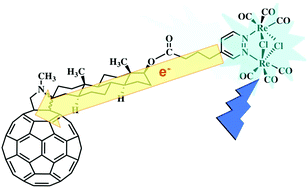Photoinduced intercomponent excited-state decays in a molecular dyad made of a dinuclear rhenium(i) chromophore and a fullerene electron acceptor unit†
Abstract
A novel molecular dyad, 1, made of a dinuclear {[Re2(μ-X)2(CO)6(μ-pyridazine)]} component covalently-linked to a fullerene unit by a carbocyclic molecular bridge has been prepared and its redox, spectroscopic, and photophysical properties – including pump–probe transient absorption spectroscopy in the visible and near-infrared region – have been investigated, along with those of its model species. Photoinduced, intercomponent electron transfer occurs in 1 from the thermally-equilibrated, triplet metal/ligand-to-ligand charge-transfer (3MLLCT) state of the dinuclear rhenium(I) subunit to the fullerene acceptor, with a time constant of about 100 ps. The so-formed triplet charge-separated state recombines in a few nanoseconds by a spin-selective process yielding, rather than the ground state, the locally-excited, triplet fullerene state, which finally decays to the ground state by intersystem crossing in about 290 ns.


 Please wait while we load your content...
Please wait while we load your content...